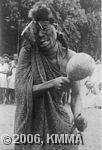




The ikinyuguri is a rattle made from a hollow gourd of the igicuma plant, which is extremely widespread in sub-Saharan Africa, and has a handle about 12 cm long made from a branch of the umuko tree. The handle is inserted into the natural opening in the gourd and passes right through the gourd. It is secured using resin or a transverse plug (umusave), which is inserted into a specially made hole in the handle and in the gourd. Fruit seeds are always placed in the gourd to produce a penetrating sharp sound. The instrument varies from 10 to 20 cm in size and is preferably spherical or pear-shaped. The external surface of the rattle is decorated with tiny 3 mm holes (/ and o) made with a sharp heated poker (uruhindu).
A less common variation of the ikinyuguri is played in Rutare. Here, the whole plant remains intact and the neck of the gourd serves as the handle. The decorations applied are very similar to those on the inzebe and the inanga, i.e. cross-shaped and oval perforations.
The ikinyuguri is used by men to accompany imihara songs in the Ryangombe cult, and also to accompany initiation rite songs (kubandwa). The performers hold the ikinyuguri in their right hand and the inzogera in their left, creating a regular rhythmic beat. Outside the realms of the cult the instrument is only used by magicians and soothsayers during their incantations. Among the Nkombo, where the instrument is known as the akanyuguri, a smaller version is used by women and is struck against the palm of the left hand.
On a musical note a technical distinction must be made: the recited texts are accompanied by free and improvised rhythms, while the songs always have fixed stable and regular binary and tertiary rhythm patterns. The intensity with which the ikinyuguri is shaken depends on the importance of the lyrics of the song.
For more information consult the following publications edited by the RMCA:
© KMMA/Jos GANSEMANS